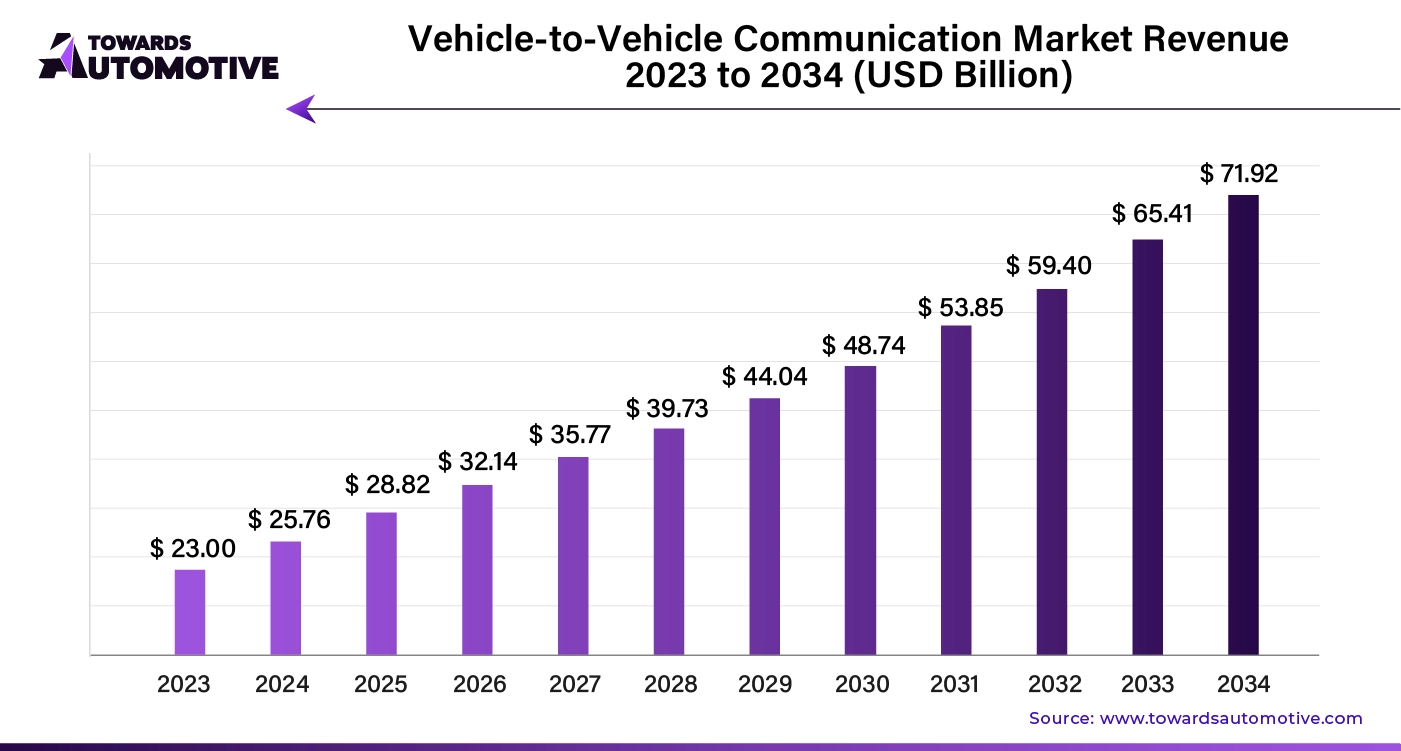In the rapidly evolving world of connected vehicles, Artificial Intelligence (AI) plays a transformative role in enhancing the efficiency, safety, and reliability of Vehicle-to-Vehicle (V2V) communication systems. By processing and analyzing large amounts of data exchanged between vehicles in real-time, AI empowers vehicles to communicate and respond quickly to dynamic road conditions, making transportation safer and more efficient.
The Growing Vehicle-to-Vehicle Communication Market
The global vehicle-to-vehicle communication market is experiencing significant growth. With a market size valued at USD 25.76 billion in 2024, it is projected to reach USD 71.92 billion by 2034, expanding at a compound annual growth rate (CAGR) of 12.03% during this period. This growth is driven by the increasing adoption of connected vehicle technologies, heightened safety awareness, and the integration of autonomous driving systems. AI plays a central role in this expansion, as its capabilities enable smarter, safer, and more efficient V2V systems.

Get All the Details in Our Solution – Download Brochure @ https://www.towardsautomotive.com/download-brochure/1459
Enhancing Safety Through Real-Time Data Processing
AI algorithms are central to the effective operation of V2V communication networks. These algorithms analyze vast quantities of real-time data shared between vehicles, enabling them to make quicker, more informed decisions. This ability is critical in preventing accidents and improving road safety. For instance, AI systems can predict potential hazards, such as sudden braking, lane changes, or an impending collision, and communicate this information to nearby vehicles. This allows other vehicles to take immediate preemptive actions, such as adjusting their speed or steering, helping to avoid accidents and reduce the risk of injury.
The integration of AI with V2V communication systems creates an intelligent network where vehicles can proactively collaborate with one another to ensure a safer driving environment. By analyzing data from multiple sources, including sensors and cameras, AI can detect dangers that may not be immediately visible to the driver, significantly enhancing situational awareness.
Optimizing Traffic Flow and Reducing Congestion
Beyond safety, AI is revolutionizing the way traffic flows on busy roads. By analyzing real-time traffic patterns and data from various sources, AI systems can make smart decisions to improve traffic management and reduce congestion. For example, AI-driven V2V systems can dynamically adjust traffic signals to optimize traffic flow, reducing wait times and the likelihood of traffic jams.
AI can also suggest alternate routes to drivers to help alleviate congestion. By predicting traffic bottlenecks or delays ahead of time, AI can recommend the most efficient paths, resulting in shorter travel times, lower fuel consumption, and fewer carbon emissions. This not only benefits individual drivers but also contributes to the overall well-being of the environment by reducing the carbon footprint of transportation.
Enabling Seamless Integration with Autonomous Vehicles
AI’s influence on V2V communication extends to the realm of autonomous vehicles. As self-driving cars continue to evolve, they rely heavily on AI to interpret data from a variety of sensors, cameras, and V2V networks. The combination of V2V communication and autonomous driving technologies creates a more cohesive and intelligent transportation system, where vehicles can “talk” to one another and make real-time decisions without human intervention.
For autonomous vehicles, V2V communication allows for seamless coordination between cars, trucks, and other road users. With the aid of AI, these vehicles can adapt to changes in their environment, avoid potential hazards, and make adjustments to their driving strategy, such as altering speed or lane positioning. The future of transportation, with the integration of V2V and AI, promises safer, smarter, and more efficient roads for all.
ZTE’s Groundbreaking AI-Based Solution for V2X Communication
A significant milestone in the advancement of V2V communication came in February 2024 when ZTE launched an AI-based solution designed to enhance Vehicle-to-Everything (V2X) capabilities in modern vehicles. This AI-enabled solution aims to boost the efficiency and reliability of V2X networks, which connect vehicles with infrastructure and other road users. ZTE’s innovative solution is expected to play a pivotal role in accelerating the widespread adoption of AI-driven V2V technologies, ultimately contributing to the development of safer and more intelligent transportation systems.
Invest in Our Premium Strategic Solution @ https://www.towardsautomotive.com/price/1459
You can place an order or ask any questions, please feel free to contact us at sales@towardsautomotive.com
Explore the comprehensive statistics and insights on automotive industry data and its associated segmentation: Get a Subscription
For Latest Update Follow Us: https://www.linkedin.com/company/towards-automotive
